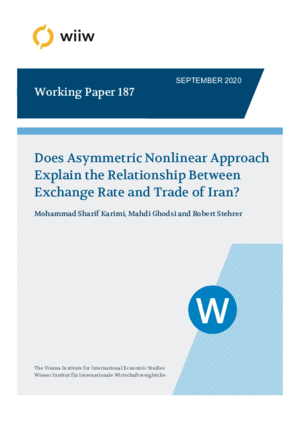Does Asymmetric Nonlinear Approach Explain the Relationship Between Exchange Rate and Trade of Iran?
Mahdi Ghodsi, Mohammad Sharif Karimi and Robert Stehrer
wiiw Working Paper No. 187, September 2020
21 pages including 6 Tables and 5 Figures
Until 2012, the Central Bank of Iran (CBI) used its policy rate to stabilise the rial’s exchange rate and, given a persistent current-account surplus, had accumulated sizeable currency reserves. In 2012, however, international sanctions against Iran intensified and the value of the rial halved against the US dollar. Since then Iran has followed a dual interest rate policy, with both a market rate and an official rate applied by the CBI to major imports. In recent years, as sanctions have cut access to foreign reserves, the gap between the two rates has widened substantially. Given these important changes in the exchange rate regime, this paper investigates the impact of the real exchange rate on the trade balance in Iran over the period 1997-2017. For this purpose, an asymmetric model is used, as the speed of the effects of changes in the exchange rate can be asymmetric. The results of the nonlinear autoregressive distributed lag model (NARDL) indicate that this is indeed the case. Results are generally consistent with the Marshall-Lerner condition: an exchange rate depreciation improves the trade balance, whereas an appreciation worsens it. However, the trade balance reacts more strongly in the short run to depreciations of the rial than to appreciations. Although the government could easily improve the trade balance in the short run through currency depreciation, policymakers should in the longer run promote non-oil exports to reduce dependency on oil and to diversify the economy.
Keywords: Exchange rate, Trade balance, asymmetric, NARDL, Iranian rial
JEL classification: F14, F30, F40
Countries covered: Iran
Research Areas: Macroeconomic Analysis and Policy
